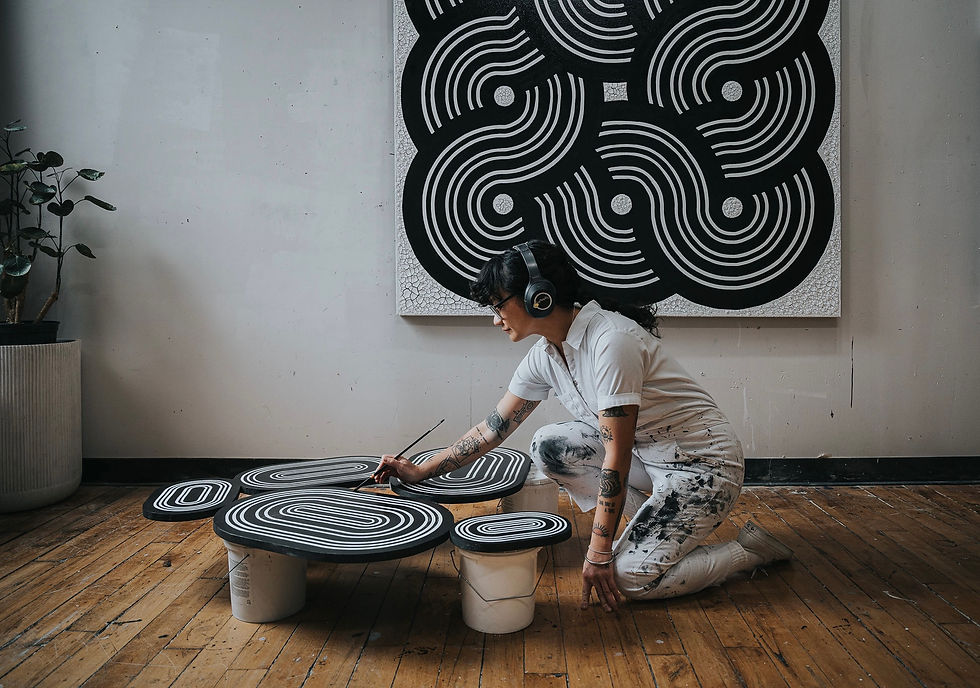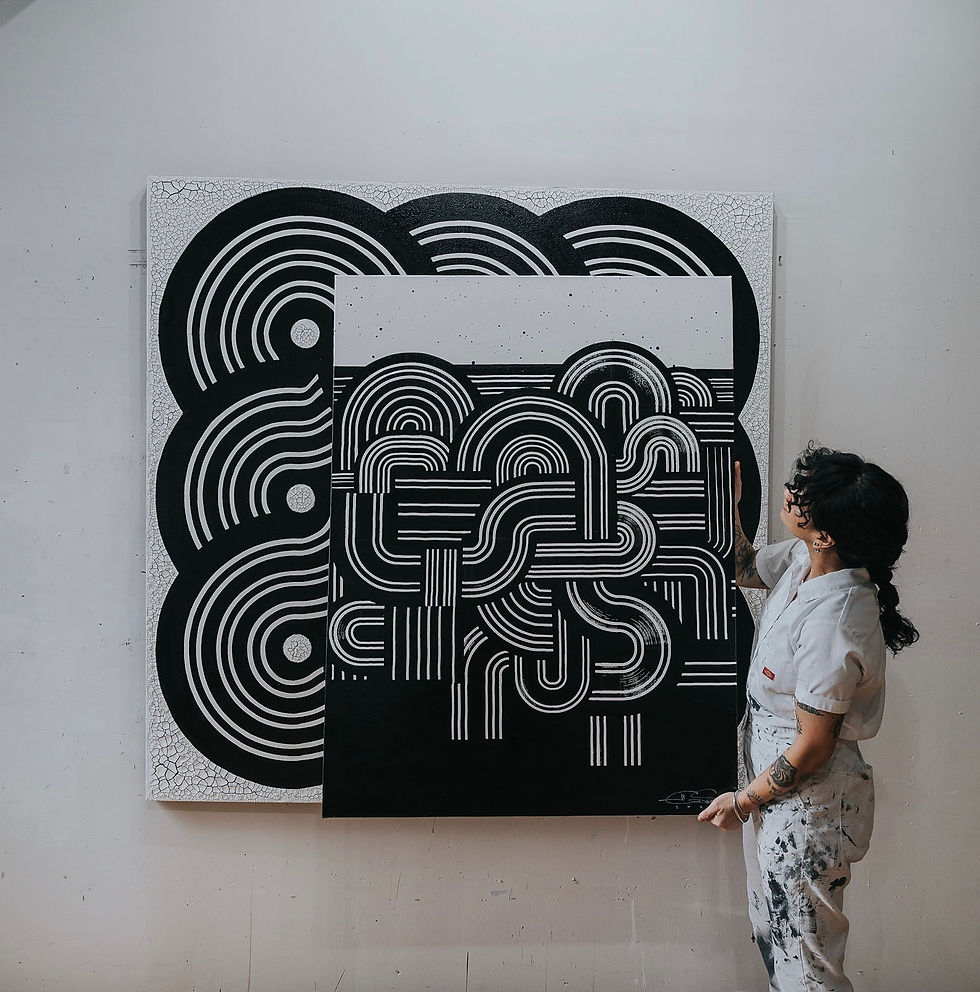Freedom Within Limits: Emon Surakitkoson, March Featured Artist
- Olivia Niuman | 52 O Street Studios

- Mar 4, 2023
- 4 min read
Updated: Mar 4, 2023
For this month’s feature, we interviewed Emon Surakitkoson, an abstract artist whose signature black and white paintings line the walls of her first floor studio. We talked about her immigration to the US as a teenager, how her art career has developed after years of hard work, and the experience she hopes to provide for her viewers through her art.

View of Emon Surakitkoson’s studio at 52 O Street Studios
Freedom within Limits
Emon Surakitkoson’s art is instantly recognizable to anyone familiar with her work. Her restricted color palette and bold lines communicate a sense of simplicity and ease, yet her path to finding her voice and supporting herself by doing what she loves has been far from easy.
Surakitkoson moved to the U.S. from Thailand when she was a teenager, and worked in food service for over a decade before transitioning to working as a full-time artist. She has been supporting herself as an artist for a number of years now, which for many artists is success in itself. When discussing her career, Surakitkoson makes it clear that being a professional artist is far from the laid-back, easy lifestyle that many people think it is. “Being an artist is easy,” she says, “being a professional artist is not.” Artists have to be intuitive and business-oriented, striking a balance between pushing themselves creatively and selling enough work to live.
Like many artists, she does enjoy the lifestyle: working when she wants, setting her own goals, and not having to rely on others. Still, this presents other difficulties: there is no predetermined path, no concrete way to gauge whether you are doing the right things at the right time. Every artist is different, so each one has to find what works best for them, which can be challenging and discouraging at times.
Surakitkoson was raised in a culture where everything had to make sense. Success in life or in a career meant success that everyone else could see and understand. There was a set path, and deviation was rare, especially for women. Moving to a new country and becoming an artist was thus a little unsettling, because validation could only be found inward. Surakitkoson explores this tension between structure and freedom through the use of her limited color palette. “If you only have these two things to work with- what can you do with them?”
High contrast and bold lines also allow her to focus on composition and to express herself clearly- something that does not always come naturally when living in a different country and speaking a second language. “I didn’t feel wholly myself until I became an artist,” she says, recounting her time working in the service industry, where she often encountered racism and discrimination. Even though she knew painting would be hard work, she fell in love with freedom of expression. “I loved the process so much that I was willing to try.”

Surakitkoson working on a piece in her studio
Dual Looking
At first glance, Surakitkoson’s work seems fairly straightforward. She uses a restricted palette of black and white with bold, undulating graphic lines. Upon closer inspection, however, the viewer can see traces of the artist’s hand: varied surfaces that are smooth or crackled, little flecks of paint, and noticeable brushstrokes. This effect is precisely what Surakitkoson is aiming for. She draws a comparison between this dual mode of looking and the way we often perceive others; first impressions are immediate and oversimplified, and extended looking reveals surprises and rewards.
“Where I grew up [in Thailand] there wasn’t any abstract art.” She explained. Art was valued for its realism and its aesthetic value, quite far from the political or conceptual art that is popular in American culture. For Surakitkoson, the process of creation and the viewer experience when viewing the work are key. She wants her viewers to enjoy a few moments of relaxation as they trace the lines with their eyes. Her use of hard-edge abstraction evokes a modern sensibility while also channeling an inward meditative viewer experience that harkens back to the traditional art of her cultural background.
Surakitkoson makes it clear that while her personal history is important to her and her story, she first and foremost cares about the quality of her work. “I just want to be a good artist. I don’t want to be identified as just a woman artist or an Asian-American artist- not because that’s not who I am, but because as an artist you want people to see your work and think it’s good without knowing what you look like.”

Surakitkoson holding one of her paintings in front of another; both exemplify her signature black-and-white style with graphic lines and textured surfaces
New Directions & Community Connections
While she has invested an incredible amount of time and energy into building an instantly recognizable oeuvre, Surakitkoson is always pushing herself to try new things. She sees herself exploring more colors in the future, and she is interested in creating more wall sculptures. While most of her pieces are textured, some of her more recent ones feature clay and mixed media in high relief, folded and swirling just like her painted lines.
She approaches her work with an exuberance and joy in the ability to create, because after so many years of working for someone else, she finally can. The result is that Surakitkoson is incredibly prolific, sometimes producing 2-3 finished pieces per week. Part of her interest in sculpture is in its laboriousness; the sculptural pieces take longer, allowing her to invest more time in a single piece while experiencing different modes of working. For an artist who truly loves being in her studio, working long hours on a single piece is welcome.
Surakitkoson is also invested in building an artistic community. With her immediate family living abroad, she has found connection with other artists to be crucial. She recently curated a group show of 52 O Street Studios artists at the Strathmore Mansion, bringing together a group of artists who work alongside each other but rarely see each other's work. At the Strathmore, she also has an upcoming solo show; titled “Sorry About My Accent,” the show will be on view from March 21 – April 29, 2023 with the opening reception on March 23rd at 7pm.
To RSVP for the opening reception, click here.



Comments